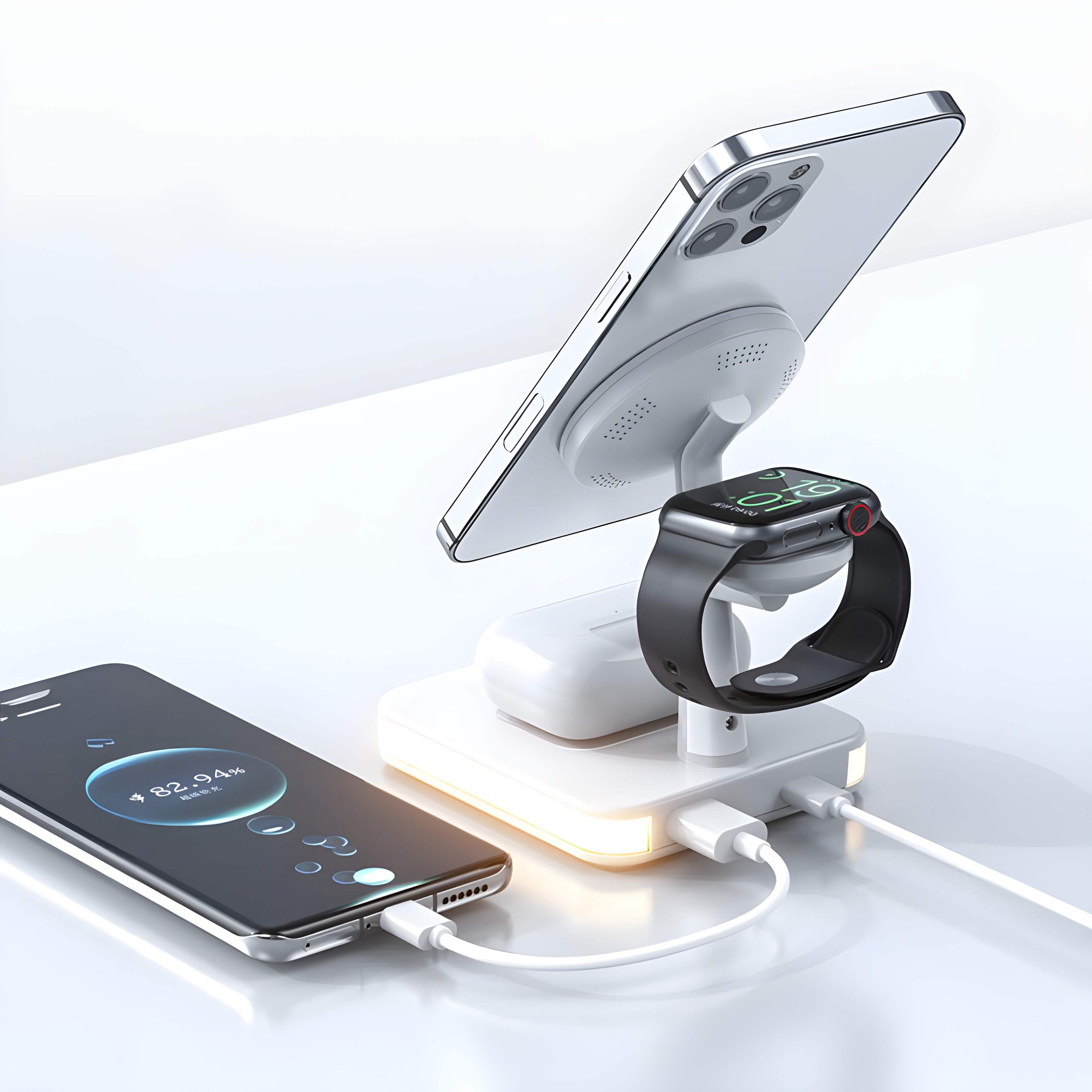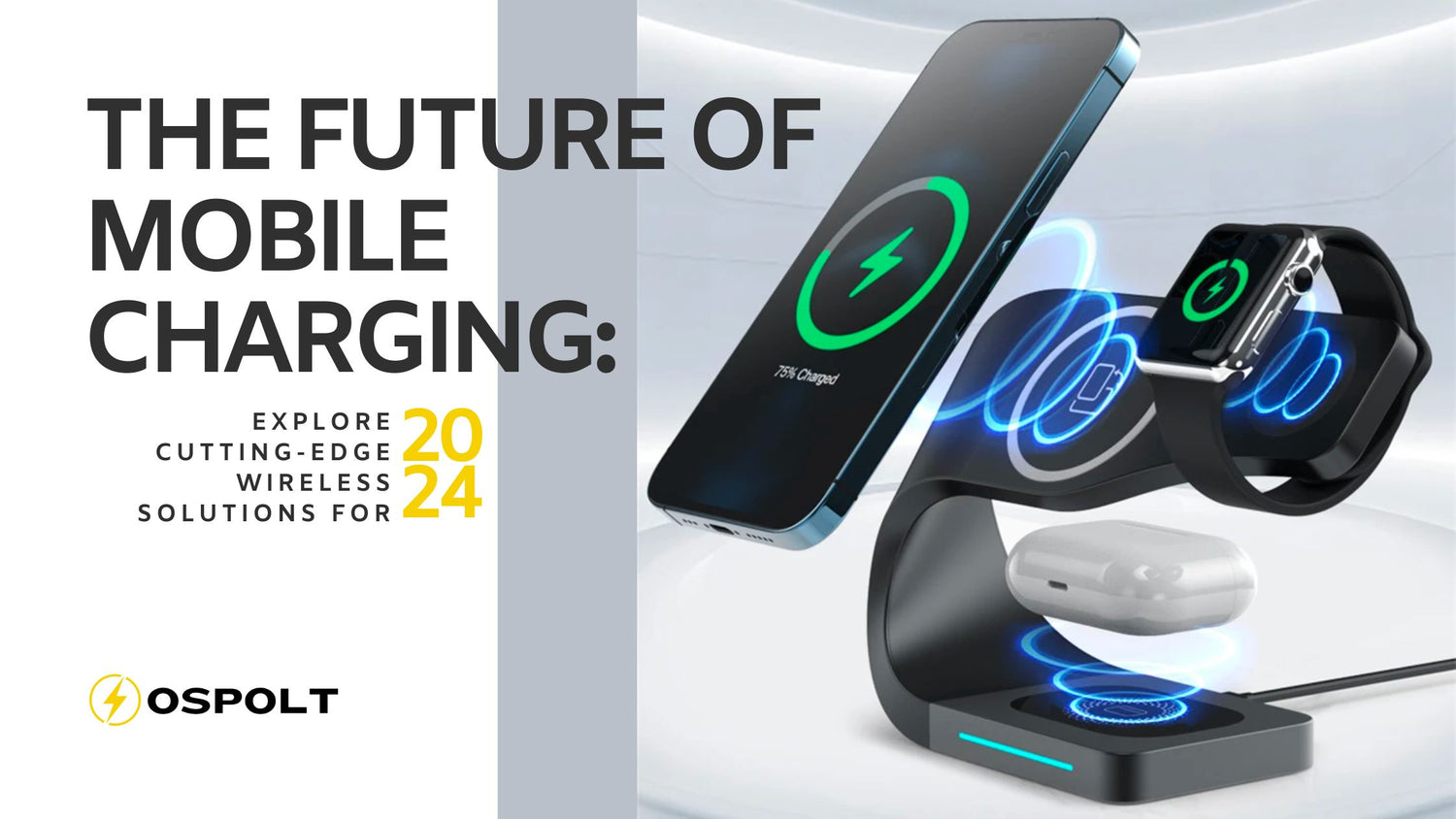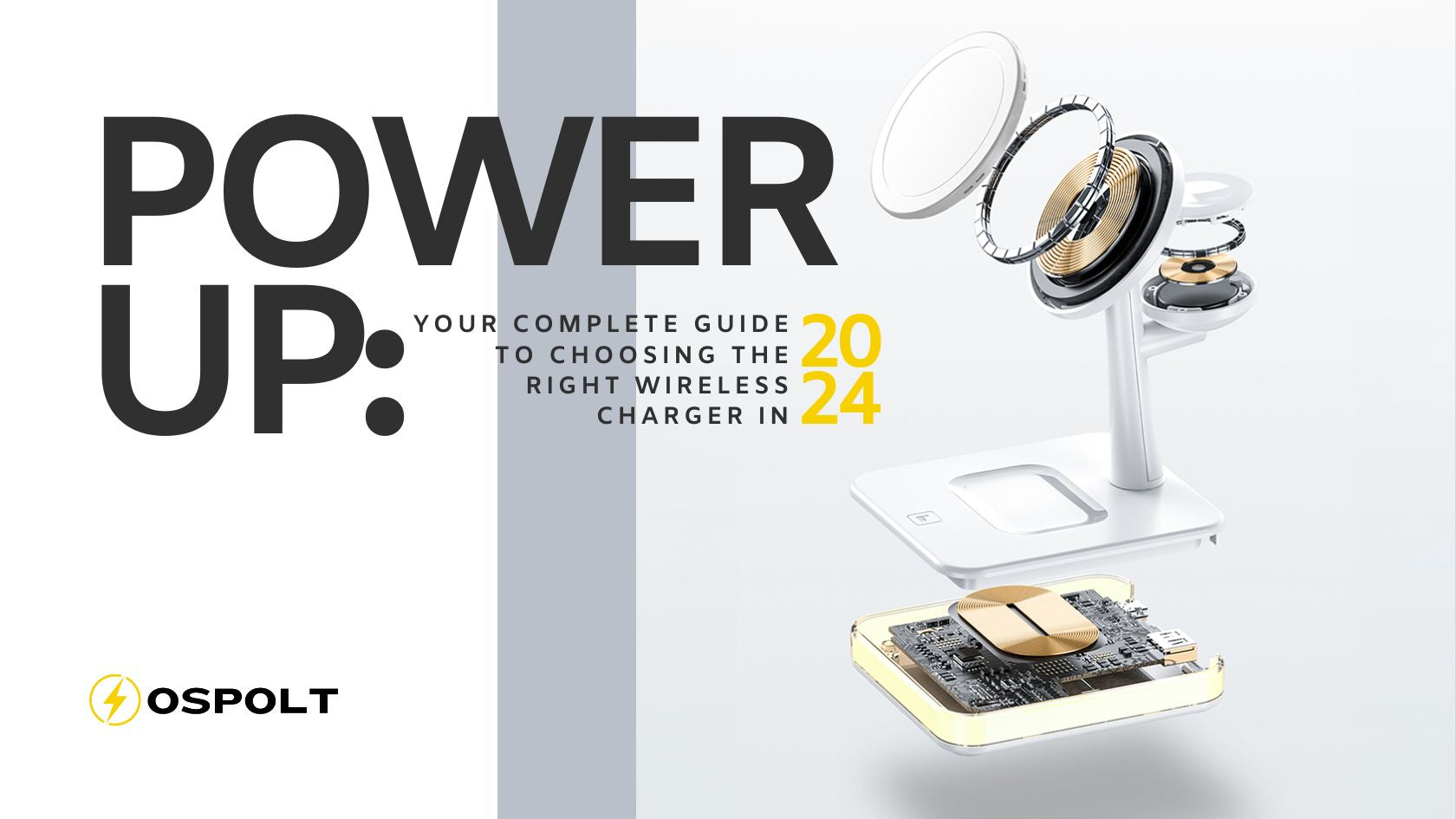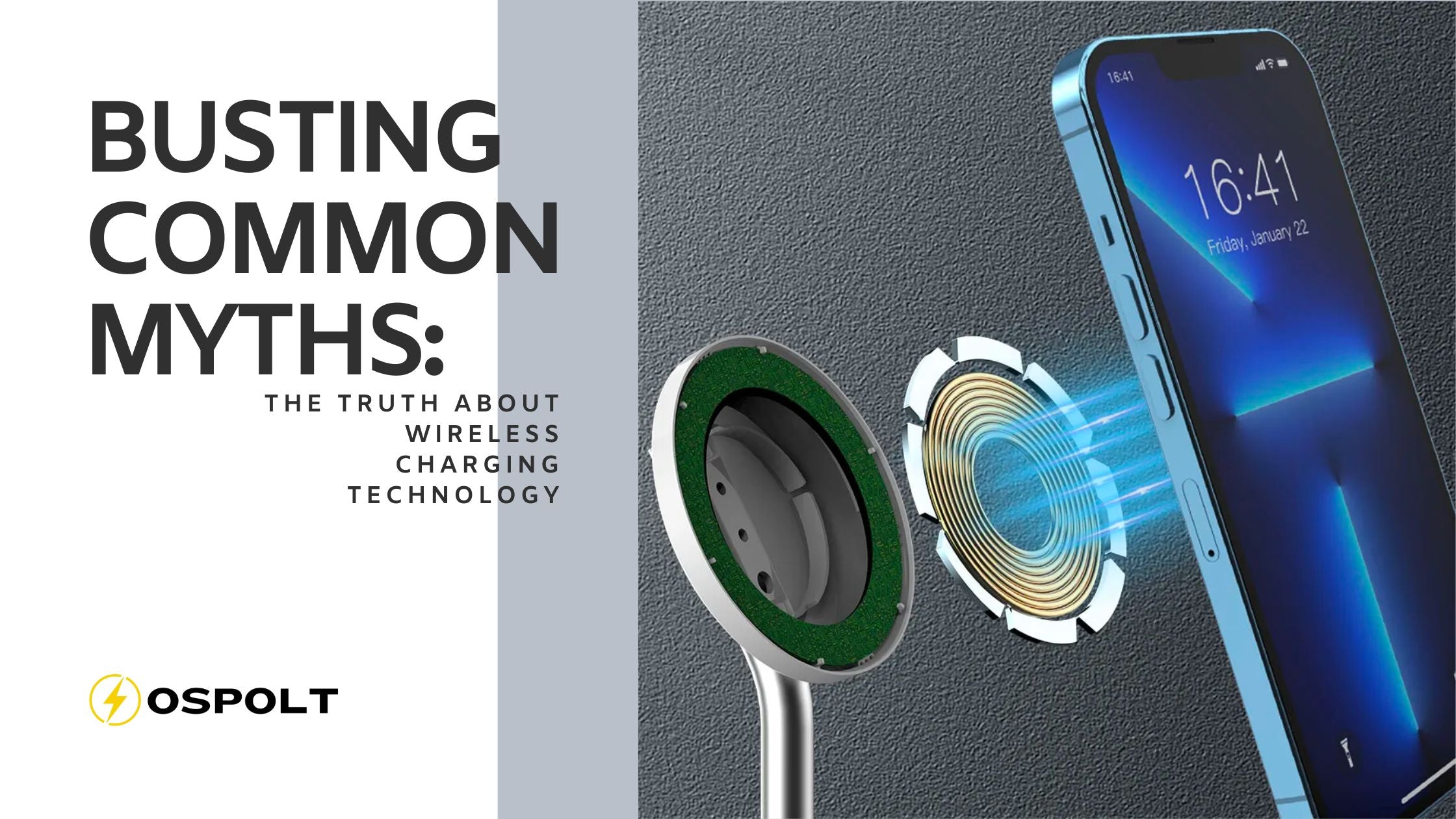Welcome to a world where the hassle of tangled cables is ancient history, and the future of charging is elegantly wireless. As our lifestyles become more mobile and technology-driven, the need for convenient, reliable, and efficient charging solutions is more important than ever. At ospolt.com, we excel in curating the finest wireless chargers on the market, rigorously tested to meet your high standards.
Wireless charging isn’t just about convenience—it's about integrating cutting-edge technology seamlessly into your daily life. Whether it's for your smartphone, tablet, or smartwatch, the ability to power up without plugging in offers an unmatched level of simplicity and style. In this guide, we’ll trace the evolution of wireless charging, examine its current capabilities, and look ahead to innovative advancements that promise to revolutionise how we power our devices.
Join us as we explore the future of mobile charging, showcasing how Ospolt’s carefully selected range of wireless charging solutions puts you at the cutting edge of technology. With our 12+12-month guarantee, not only do we promise quality, but we also ensure your peace of mind. Ready to cut the cords? Let’s dive into the transformative world of wireless charging.
The Evolution of Wireless Charging

The journey of wireless charging is a tale of innovation and ingenuity that spans over a century. Initially conceptualised by Nikola Tesla in the early 1900s through his experiments with electromagnetic induction, the idea of transmitting power without wires was revolutionary. However, it wasn’t until the late 20th century that this concept began to find practical applications in everyday technology.
From Concept to Reality
The first real-world applications of wireless charging appeared in medical devices and electric toothbrushes in the 1990s. These devices utilised inductive charging to safely power up without direct electrical contacts, paving the way for broader adoption in consumer electronics.
Entering the Consumer Market
In 2008, the Wireless Power Consortium was formed, and it introduced the Qi standard, which became the most widely adopted format for wireless charging. This standard ensured that devices and chargers from different manufacturers could work together seamlessly, boosting consumer confidence and industry growth.
Smartphones and Beyond
The adoption of wireless charging by major smartphone manufacturers in the early 2010s marked a significant turning point. Companies like Samsung, Apple, and Google began embedding wireless charging capabilities into their flagship devices, making it a staple feature for modern smartphones. This integration helped push wireless charging into the limelight, making it a must-have feature for new devices.
Innovation and Integration
As the technology matured, wireless chargers became more efficient and faster, with new innovations such as multi-coil chargers that allowed for a larger charging area and more positional freedom. The introduction of resonant charging expanded the possibilities further, offering a slightly longer range and the ability to charge multiple devices simultaneously.
Today, as we stand on the brink of new advancements, wireless charging technology is poised to become more than just a convenient charging method. With the development of true wireless power—capable of charging devices over distances and without the need for a charging pad—we are moving closer to a world where constant connectivity and convenience are seamlessly integrated into our environments.
Current State of Wireless Charging Technology
Wireless charging has transformed from a niche idea into a standard feature for many of today’s smartphones, smartwatches, and other portable gadgets. The technology not only simplifies the charging process but also introduces an element of sophistication to our tech accessories. Here’s where we stand today:
Widespread Adoption of Qi Standard
The Qi standard, developed by the Wireless Power Consortium, has become the backbone of the wireless charging industry. It ensures compatibility across a wide range of devices and chargers, making it easier for consumers to adopt wireless charging without worrying about the specific make or model of their gadgets. This standard supports up to 15 watts of wireless power, providing a balance of speed and efficiency for everyday charging needs.
Enhanced Charging Speeds

Modern wireless chargers are not just about eliminating wires; they’re about doing it quickly. Today's high-end models can charge compatible devices at speeds comparable to their wired counterparts, thanks to advancements like fast charging protocols and improved hardware designs. For example, ospolt.com offers chargers like the 3-in-1 20W Fast Wireless Charging Dock that support fast charging for devices like the latest Apple iPhones and Samsung Galaxy phones, ensuring your device spends less time tethered to a charger.
Smart Features for Intelligent Charging
Many wireless chargers now come equipped with smart features such as foreign object detection, which automatically halts charging if a metal object is detected on the pad to prevent overheating or damage. Others include built-in cooling systems to keep the charger and your device at optimal temperatures during fast charging sessions.
Design and Aesthetics
As wireless chargers become more common, aesthetics have also taken centre stage. Manufacturers are incorporating sleek, minimalist designs that not only blend in with home decor but also enhance it. Products like the 4-in-1 MagSafe Fast Wireless Charger for Apple iPhone, for instance, feature elegant designs that complement any setting, from office desks to bedside tables, making them a functional yet fashionable addition to your space.
Eco-Friendliness and Sustainability
With an increasing focus on sustainability, many wireless charger manufacturers are adopting eco-friendly practices, including the use of recycled materials and non-toxic components. This shift not only supports environmental goals but also appeals to eco-conscious consumers looking to reduce their ecological footprint.
Benefits of Wireless Charging
Wireless charging offers more than just the elimination of cables—it enhances the user experience in several significant ways. Here are some of the primary benefits that make wireless charging a valuable feature for many device users:
Convenience
Perhaps the most obvious benefit is the sheer convenience. No more fumbling with cables or struggling to plug your device in the dark. With a wireless charger, you simply drop your device on the pad, and it starts charging. This ease of use is perfect for busy individuals who need to quickly power up their devices frequently throughout the day.
Reduced Wear and Tear
Every time you plug a cable into your device, you risk damaging the port, which can lead to costly repairs or replacements. Wireless chargers eliminate this risk by using a contactless system, which means less wear and tear on your device’s hardware over its lifespan.
Cleaner and More Organised Spaces
Wireless chargers help maintain a cleaner and more organized charging area. Without the clutter of multiple cables, your workspace or nightstand looks tidier and more stylish. This is particularly appealing to minimalist enthusiasts or those who value a neat and orderly environment.
Safer Charging Environment
Wireless charging stations often come with built-in safety features that make them safer to use than traditional chargers. These include overvoltage protection, undercurrent protection, and foreign object detection, which help prevent accidents like electrical shorts or overheating.
Compatibility and Versatility
Many wireless chargers are designed to work with a wide range of devices, from smartphones and tablets to smartwatches and earbuds. This versatility means you can use a single charger for multiple devices, reducing the need for different kinds of chargers and simplifying your technology needs.
Advanced Features for Enhanced Experience
Modern wireless chargers are equipped with features that go beyond basic charging. For instance, some chargers offer LED indicators to show charging status, or the ability to charge multiple devices at once, enhancing the overall functionality and user experience.
Wireless charging is reshaping how we power our devices, offering a blend of practicality, safety, and aesthetic appeal that is hard to match with traditional charging methods. Whether you're at home, in the office, or on the go, wireless charging can make your life easier and more efficient.
Innovations on the Horizon

The future of wireless charging is brimming with possibilities that could further revolutionise how we power our devices. Here are some of the most promising innovations on the horizon:
Increased Range and Flexibility
Research is ongoing into developing wireless charging technologies that can charge devices over greater distances. Imagine charging your phone as you walk around your room without it needing to be on a charging pad.
Faster Charging Speeds
As technology advances, so does the speed at which devices can be charged. Future wireless chargers are expected to rival or even exceed the speed of the fastest wired chargers available today, reducing downtime for device charging.
Integration into More Products and Spaces
Expect to see wireless charging capabilities integrated into more furniture, vehicles, and public spaces. This widespread integration will ensure that keeping your devices charged becomes a seamless part of your daily activities.
Smart Wireless Charging Systems
Emerging smart charging systems can intelligently manage the power distribution among multiple devices and prioritise charging based on your usage patterns and battery levels. This will optimise energy use and enhance device longevity.
Challenges and Considerations
Despite the rapid advancement in wireless charging technology, several challenges need addressing to improve its efficiency and adoption:
Energy Efficiency
Wireless chargers currently lag behind wired chargers in terms of energy efficiency. They often generate more heat and have a higher energy loss, which researchers are working to minimise.
Standardisation Issues
While the Qi standard has helped unify charging protocols, ongoing innovation necessitates continuous updates and compatibility checks to ensure new devices and chargers can work seamlessly together.
Cost and Accessibility
As features improve, the cost of high-end wireless charging devices can be a barrier to widespread adoption. Efforts are needed to make these technologies more affordable and accessible to a broader audience.
Impact on Consumer Electronics
Wireless charging is increasingly becoming a standard feature expected by consumers, influencing the design and functionality of consumer electronics in several ways:
Device Design
The adoption of wireless charging influences manufacturers to design slimmer, more robust devices without the need for large charging ports. This can lead to more innovative and aesthetically pleasing designs.
Market Differentiation
Manufacturers are incorporating wireless charging as a key feature to differentiate their products in a crowded market. Devices that offer advanced wireless charging capabilities often stand out from the competition.
Consumer Expectations
As more consumers experience the benefits of wireless charging, their expectations for convenience, speed, and integration are rising. This shift is pushing manufacturers to prioritise wireless charging in their product development strategies.
Conclusion
As we have explored throughout this journey, the landscape of mobile charging is evolving rapidly, shaped by the innovative strides in wireless technology. From the enhanced convenience and reduced wear and tear offered by current wireless chargers to the thrilling prospects of increased range and faster charging speeds on the horizon, wireless charging is set to redefine our interaction with technology.
The integration of wireless charging into everyday life—be it through furniture, public spaces, or even our own homes—illustrates a future where keeping our devices powered is as seamless as it is intuitive. As technology continues to advance, we can anticipate even smarter systems that not only charge our devices but also adapt to our lifestyles, making efficient use of energy and enhancing device longevity.
This progression not only promises greater convenience and aesthetic simplicity but also pushes manufacturers to innovate continually. As consumers, our expectations are evolving, driving the market towards more sophisticated, energy-efficient, and universally compatible charging solutions.
Thank you for exploring the dynamic world of wireless charging with us. The future is bright and untethered, and we are just beginning to tap into its vast potential.





Leave a comment
All comments are moderated before being published.
This site is protected by hCaptcha and the hCaptcha Privacy Policy and Terms of Service apply.